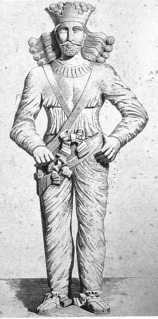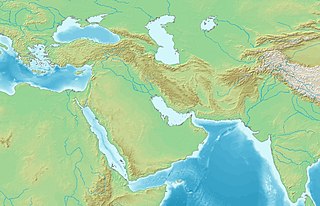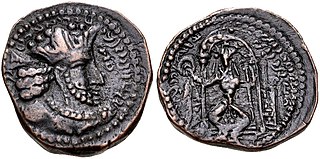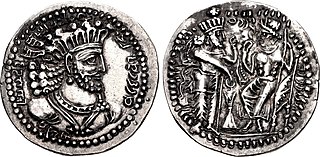Related Research Articles

Peroz I was the Sasanian King of Kings of Iran from 459 to 484. A son of Yazdegerd II, he disputed the rule of his elder brother and incumbent king Hormizd III, eventually seizing the throne after a two-year struggle. His reign was marked by war and famine. Early in his reign, he successfully quelled a rebellion in Caucasian Albania in the west, and put an end to the Kidarites in the east, briefly expanding Sasanian rule into Tokharistan, where he issued gold coins with his likeness at Balkh. Simultaneously, Iran was suffering from a seven-year famine. He soon clashed with the former subjects of the Kidarites, the Hephthalites, who possibly had previously helped him to gain his throne. He was defeated and captured twice by the Hephthalites and lost his recently acquired possessions.

Balash was Sasanian King of Kings of Iran from 484 to 488. He was the brother and successor of Peroz I, who had been defeated and killed by a Hephthalite army near Balkh.

Bahram II was the fifth Sasanian King of Kings (shahanshah) of Iran, from 274 to 293. He was the son and successor of Bahram I. Bahram II, while still in his teens, ascended the throne with the aid of the powerful Zoroastrian priest Kartir, just like his father had done.

Shapur I was the second Sasanian King of Kings of Iran. The dating of his reign is disputed, but it is generally agreed that he ruled from 240 to 270, with his father Ardashir I as co-regent until the death of the latter in 242. During his co-regency, he helped his father with the conquest and destruction of Arab city of Hatra, whose fall was facilitated, according to Islamic tradition, by the actions of his future wife al-Nadirah. Shapur also consolidated and expanded the empire of Ardashir I, waged war against the Roman Empire and seized its cities of Nisibis and Carrhae while he was advancing as far as Roman Syria. Although he was defeated at the Battle of Resaena in 243 by Roman emperor Gordian III, he was the following year able to win the Battle of Misiche and force the new Roman Emperor Philip the Arab to sign a favorable peace treaty that was regarded by the Romans as "a most shameful treaty".

The Hephthalites, sometimes called the White Huns, were a people who lived in Central Asia during the 5th to 8th centuries. They existed as an Empire, the Imperial Hephthalites, and were militarily important from 450 CE, when they defeated the Kidarites, to 560 CE, date of their defeat to combined First Turkic Khaganate and Sasanian Empire forces. After 560 CE, they formed "principalities" in the area of Tokharistan, under the suzerainty of the Western Turks and the Sasanian Empire, before being taken over by the Tokhara Yabghus in 625 CE.

Jamasp was Sasanian King of Kings of Iran from 496 to 498/9. He was a son of Peroz I and younger brother of Kavad I. Jamasp was installed on the Sasanian throne upon the deposition of the latter by the nobility and clergy.

Kushano-Sasanian Kingdom is a historiographic term used by modern scholars to refer to a branch of the Sasanian Persians who established their rule in Bactria and in northwestern Indian subcontinent during the 3rd and 4th centuries CE at the expense of the declining Kushans. They captured the provinces of Sogdiana, Bactria and Gandhara from the Kushans in 225 CE. The Sasanians established governors for the Sasanian Empire, who minted their own coinage and took the title of Kushanshas, i.e. "Kings of the Kushans". They are sometimes considered as forming a "sub-kingdom" inside the Sasanian Empire. This administration continued until 360-370 CE, when the Kushano-Sasanians lost much of its domains to the invading Kidarite Huns, whilst the rest was incorporated into the imperial Sasanian Empire. Later, the Kidarites were in turn displaced by the Hephthalites. The Sasanians were able to re-establish some authority after they destroyed the Hephthalites with the help of the Turks in 565, but their rule collapsed under Arab attacks in the mid 7th century.

The First Perso-Turkic War was fought during 588–589 between the Sasanian Empire and Hephthalite principalities and its lord the Göktürks. The conflict started with the invasion of the Sasanian Empire by the Turks and ended with a decisive Sasanian victory and the reconquest of lost lands.

The Battle of Gol-Zarriun, also Battle of Bukhara, took place in c. 560 when the Sasanian Empire allied with the First Turkic Khaganate against the Hephthalite Empire.

Kushanshah was the title of the rulers of the Kushano-Sasanian Kingdom, the parts of the former Kushan Empire in the areas of Sogdiana, Bactria and Gandhara, named Kushanshahr and held by the Sasanian Empire, during the 3rd and 4th centuries CE. They are collectively known as Kushano-Sasanians, or Indo-Sasanians.

Peroz I Kushanshah was Kushanshah of the Kushano-Sasanian Kingdom from 245 to 275. He was the successor of Ardashir I Kushanshah. He was an energetic ruler, who minted coins in Balkh, Herat, and Gandhara. Under him, the Kushano-Sasanians further expanded their domains into the west, pushing the weakened Kushan Empire to Mathura in North India.

Hormizd I Kushanshah was Kushanshah of the Kushano-Sasanian Kingdom from 275 to 300. His reign was marked by his rebellion against his brother and suzerain the Sasanian King of Kings Bahram II.

Ardashir I Kushanshah was the first Kushanshah of the Kushano-Sasanian Kingdom from 233 to 245. He was succeeded by Peroz I Kushanshah.

Hormizd II Kushanshah, was Kushanshah of the Kushano-Sasanian Kingdom from 300 to 303. Like his predecessors, he was, in effect a governor of the Sasanian Empire for the eastern regions of Marw, Tukharistan and Gandhara which had been captured following the defeat of the Kushan Empire in 230. Since the reign of his predecessor Hormizd I Kushanshah, copper drachms were minted with the names of two local governors, Meze and Kavad.

BahramKushanshah, was the last Kushanshah of the Kushano-Sasanian Kingdom from 330 to 365. He was the successor of Peroz II Kushanshah.

Khodadad Rezakhani is an Iranian historian of late antique Central and West Asia. He has been Associate Research Scholar at The Sharmin and Bijan Mossavar-Rahmani Center for Iran and Persian Gulf Studies Princeton University from 2016 to 2020.

Peroz II Kushanshah was the penultimate Kushanshah of the Kushano-Sasanian Kingdom from 303 to 330. He was the successor of Hormizd II Kushanshah.

Peroz, was according to modern scholarship an early Kidarite ruler in Gandhara, right after the end of Kushano-Sasanians.
Kadagistan was the name of an eastern Sasanian province in the region of Tokharistan, established by Khosrow I after his victory over the Hephthalite Empire in 557. The capital of the province was Warlu, a city located in the valley of the Kunduz River.
